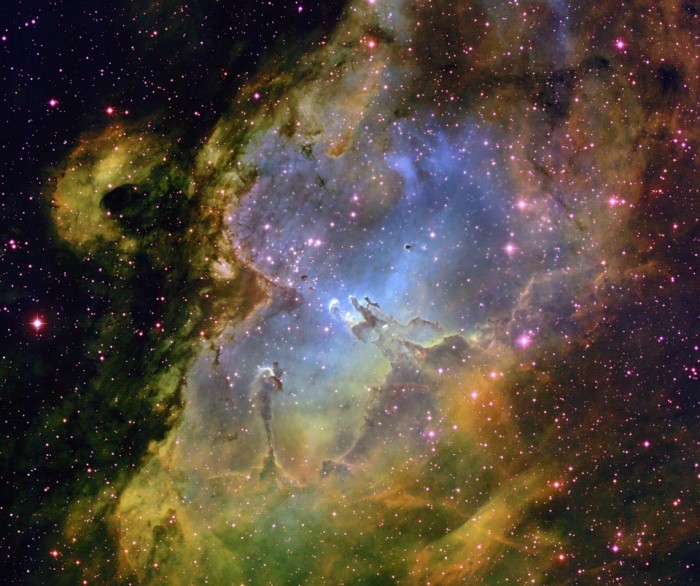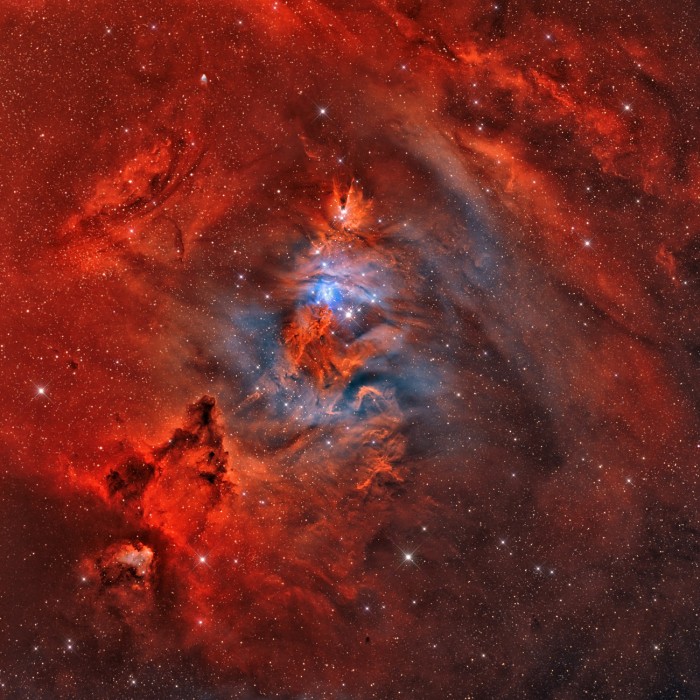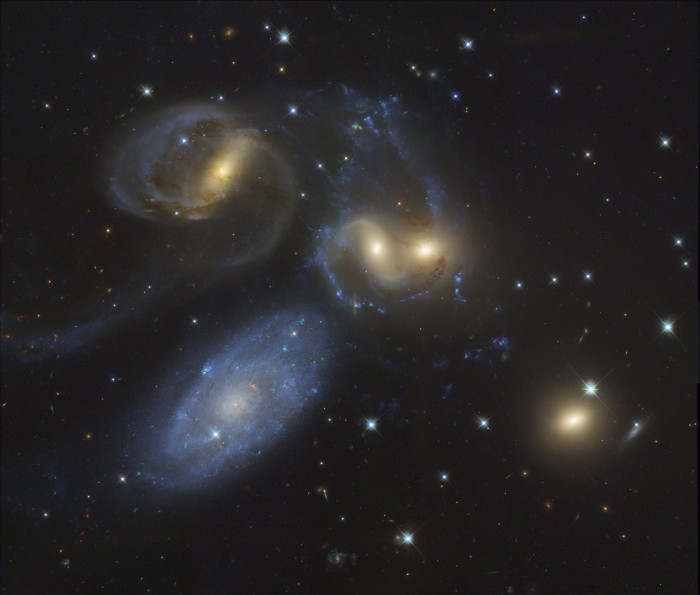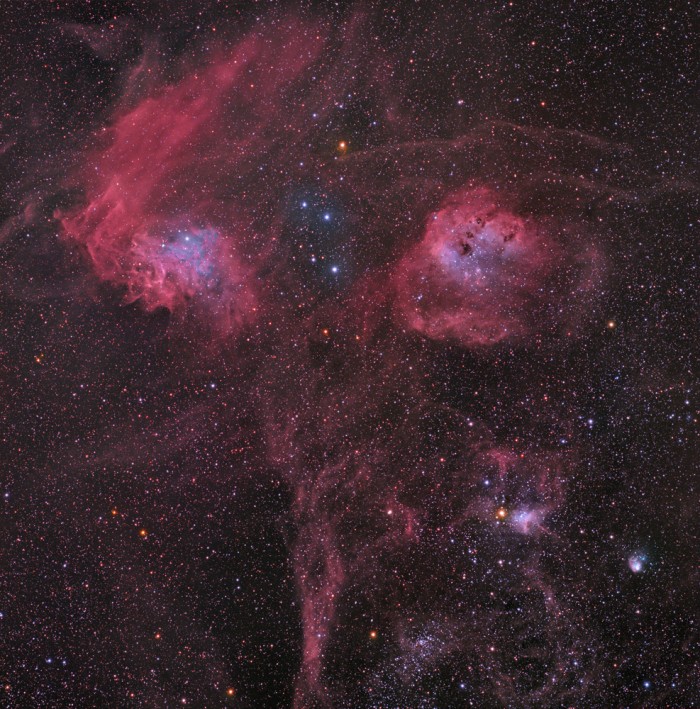The Eagle Nebula
From NASA APOD:
From afar, the whole thing looks like an Eagle. A closer look at the Eagle Nebula, however, shows the bright region is actually a window into the center of a larger dark shell of dust. Through this window, a brightly-lit workshop appears where a whole open cluster of stars is being formed. In this cavity tall pillars and round globules of dark dust and cold molecular gas remain where stars are still forming. Already visible are several young bright blue stars whose light and winds are burning away and pushing back the remaining filaments and walls of gas and dust. The Eagle emission nebula, tagged M16, lies about 6500 light years away, spans about 20 light-years, and is visible with binoculars toward the constellation of the Serpent (Serpens). This picture combines three specific emitted colors and was taken with the 0.9-meter telescope on Kitt Peak, Arizona, USA.
NGC 2264 in Monoceros
From NASA APOD:
What do the following things have in common: a cone, the fur of a fox, and a Christmas tree? Answer: they all occur in the constellation of the unicorn (Monoceros). Pictured above as a star forming region cataloged as NGC 2264, the complex jumble of cosmic gas and dust is about 2,700 light-years distant and mixes reddish emission nebulae excited by energetic light from newborn stars with dark interstellar dust clouds. Where the otherwise obscuring dust clouds lie close to the hot, young stars they also reflect starlight, forming blue reflection nebulae. The above image spans about 3/4 degree or nearly 1.5 full moons, covering 40 light-years at the distance of NGC 2264. Its cast of cosmic characters includes the Fox Fur Nebula, whose convoluted pelt lies below center, bright variable star S Mon immersed in the blue-tinted haze, and the Cone Nebula near the tree’s top. Of course, the stars of NGC 2264 are also known as the Christmas Tree star cluster. The triangular tree shape traced by the stars appears sideways here, with its apex at the Cone Nebula and its broader base centered near S Mon.
Stephan's Quintet
From NASA APOD:
The first identified compact galaxy group, Stephan’s Quintet is featured in this eye-catching image constructed with data drawn from the extensive Hubble Legacy Archive. About 300 million light-years away, only four of these five galaxies are actually locked in a cosmic dance of repeated close encounters. The odd man out is easy to spot, though. The interacting galaxies, NGC 7319, 7318A, 7318B, and 7317 have an overall yellowish cast. They also tend to have distorted loops and tails, grown under the influence of disruptive gravitational tides. But the predominantly bluish galaxy, NGC 7320, is closer, just 40 million light-years distant, and isn’t part of the interacting group. Stephan’s Quintet lies within the boundaries of the high flying constellation Pegasus. At the estimated distance of the quartet of interacting galaxies, this field of view spans about 500,000 light-years. However, moving just beyond this field, above and to the left, astronomers can identify another galaxy, NGC 7320C, that is also 300 million light-years distant. Of course, including it would bring the interacting quartet back up to quintet status.
The Aurigae Nebulae
From NASA APOD:
Rich in star clusters and nebulae, the ancient constellation of Auriga, the Charioteer, rides high in northern winter night skies. Composed from narrow and broadband filter data and spanning nearly 8 Full Moons (4 degrees) on the sky, this deep telescopic view recorded in January shows off some of Auriga’s celestial bounty. The field includes emission region IC 405 (top left) about 1,500 light-years distant. Also known as the Flaming Star Nebula, its red, convoluted clouds of glowing hydrogen gas are energized by hot O-type star AE Aurigae. IC 410 (top right) is significantly more distant, some 12,000 light-years away. The star forming region is famous for its embedded young star cluster, NGC 1893, and tadpole-shaped clouds of dust and gas. IC 417 and NGC 1931 at the lower right, the Spider and the Fly, are also young star clusters embedded in natal clouds that lie far beyond IC 405. Star cluster NGC 1907 is near the bottom edge of the frame, just right of center. The crowded field of view looks along the plane of our Milky Way galaxy, near the direction of the galactic anticenter.
The Stars As Seen From the ISS
This video was taken by the crew of Expedition 30 on board the International Space Station. The sequence of shots was taken January 23, 2012 from 08:01:56 to 08:16:08 GMT, on a pass from the Pacific Ocean, just off the coast of Mexico, to the North Atlantic Ocean, east of Newfoundland. This video focuses on the stars over the Caribbean Sea, the eastern United States, and southeastern Canada. The Milky Way can be faintly seen throughout the star field as the ISS travels northeast over the Caribbean Sea and towards the southeastern United States. As the ISS continues northeast , lightning flashes can be seen over the southeastern United States before flying over Washington, D.C., Philadelphia, and New York City. The pass ends over southeastern Quebec and the New Brunswick area.
This video was taken by the crew of Expedition 30 on board the International Space Station. The sequence of shots was taken January 22, 2012 from 13:35:50 to 13:48:02 GMT, on a pass over the North Pacific Ocean, from west of Hawaii to just southwest of Vancouver. This video mainly involves the stars over the North Pacific Ocean as the ISS travels northeast towards southwestern Canada. The camera used to take this time-lapse sequence captures a great multitude of stars and constellations as looks west out of the Cupola. The pass ends near Vancouver, where the Aurora Borealis is seen.
via NASA



